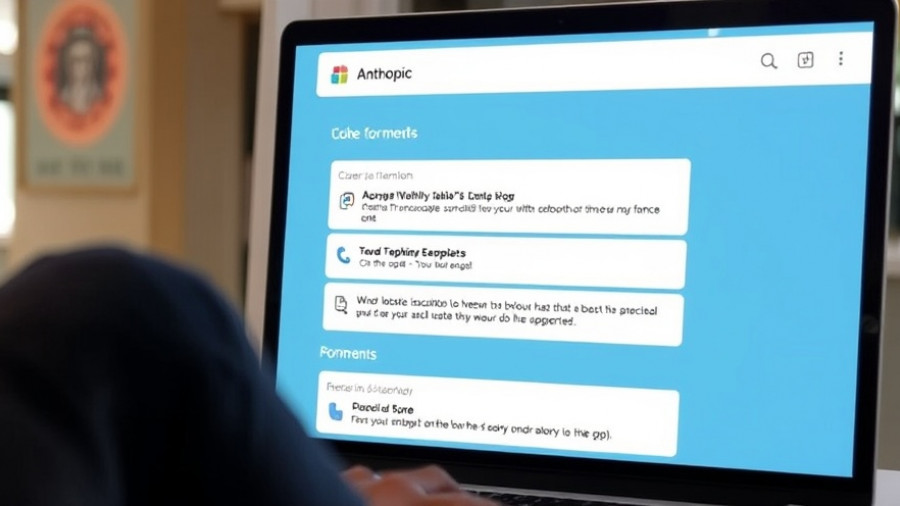
Forecasting the Future of Crypto: Insights from Claude AI
The world of cryptocurrency is often unpredictable, with prices swinging wildly from one month to the next. However, a recent analysis by Claude AI offers a fresh perspective on three major players in the crypto market: XRP, Dogecoin, and Pi Coin. As we look towards the end of 2025, Claude AI's predictions provide a compelling glimpse into how these cryptocurrencies could perform amidst shifting financial landscapes and regulatory environments.
What Makes Claude AI's Predictions Stand Out?
Claude AI is not just another trading tool. Developed by Anthropic as a sophisticated conversational agent, it leverages complex algorithms to analyze market trends and historical data, producing forecasts that aim to be more accurate than traditional methods. Its predictions hinge on several crucial parameters, including market sentiment, regulatory changes, and technological advancements within the blockchain space.
XRP's Stratospheric Potential: Will It Reach $24?
Claude AI suggests that XRP, currently priced at around $2.86, could skyrocket to $24 by 2025. This projected increase of over 739% hinges on several factors, including Ripple's resolution of its legal issues with the SEC and growing adoption of its payment system by global organizations. In July 2023, XRP reached a peak of $3.65, and Claude AI highlights the importance of this price as a potential support level for future trading.
What’s more, the anticipated approval of XRP ETFs could further enhance its market viability, drawing in institutional investors. The UN Capital Development Fund has already acknowledged XRP as a viable remittance option for developing economies, suggesting that the token's practical applications are rapidly expanding.
Dogecoin: Can It Surpass Expectations?
Once deemed a joke currency, Dogecoin has proven itself more prevalent than many investors could have imagined. Claude AI posits that Dogecoin's unique community and brand presence could see its value reach new heights as cryptocurrency gains mainstream acceptance. With the recent endorsement from high-profile figures and increasing transactions on the Dogecoin network, the future looks promising.
Investor enthusiasm, driven by social media trends and celebrity endorsements, remains a double-edged sword. Nonetheless, Claude AI’s analysis indicates that continuing innovation and market engagement could progressively tilt the scales favorably for Dogecoin. As we move closer to 2025, it will be interesting to observe how market dynamics evolve.
The Rise of Pi Coin: A Surprising Contender
Pi Coin has emerged as a significant player in the crypto ecosystem, largely due to its accessibility to everyday users. Claude AI's forecasts highlight the potential for Pi Network to disrupt traditional models of cryptocurrency mining and exchange. Unlike many cryptos requiring expensive hardware to mine, Pi allows users to mine on their mobile devices.
If Pi Network can effectively transition from a user base to an established currency in the market by 2025, it could well imitate the explosive growth trajectories of more traditional cryptocurrencies. A successful launch and high user adoption could see Pi prices soar, solidifying its position in the crypto hierarchy.
Navigating Regulatory Changes: A Key Influencer
The landscape of cryptocurrency regulation is continuously evolving, and recent developments indicate that clearer guidelines could usher in a new phase of market stability and investor confidence. The recent signing of the GENIUS Act by President Trump marks a significant shift in the U.S. approach to cryptocurrencies, specifically targeting stablecoins. Such legislative actions are poised to create a foundation for broader market acceptance and security.
Claude AI reflects that these changes could play a critical role in the anticipated bullish phase for altcoins in 2025. As regulatory clarity improves, asset valuation could become more stable, encouraging cautious investors to enter the market.
Investor Sentiment and Market Volatility
Despite the analytical forecasts made by Claude AI, it is essential to remain cautious; the cryptocurrency market is notoriously volatile. Predictions are shaped not only by hard data but also by investor sentiment, which can swing massively based on external factors such as economic news, technological advancements, and shifts in social media narratives.
If lessons from previous market cycles are any indication, it is vital for investors to approach predictions with healthy skepticism while staying informed about market changes. Engaging in long-term strategies rather than attempting to time the market may yield better results, especially with emerging technologies influencing the crypto space.
Final Thoughts: The Future of Cryptocurrencies
The predictions from Claude AI about XRP, Dogecoin, and Pi Coin offer a tantalizing glimpse of what could be in store for the cryptocurrency market by 2025. As advancements in technology and shifts in regulation pave the way for innovative changes, savvy investors would do well to remain alert to the evolving landscape. The allure of substantial returns should be tempered with informed decision-making and an understanding of market fundamentals.
As we draw closer to 2025, keeping tabs on Claude AI's future analyses and remaining engaged with the latest industry news could provide a competitive edge in navigating the labyrinthine world of cryptocurrencies.
 Add Row
Add Row  Add
Add 




Write A Comment